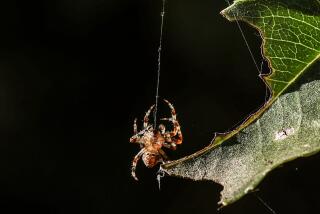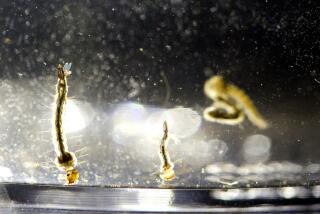EARTHWATCH : Good Bugs : A sprinkling of ladybugs and mantises can keep the really nasty insects away from your cookouts.
Wander into your back yard during the summer months and you can almost hear the jubilation.
“Barbecue!” roar the ants. “Fruits and vegetables!’ add the aphids and white ash flies. “People!” say the mosquitoes and wasps, invariably followed by the not-so-happy retort from your family, “Let’s go inside.”
Yesterday, the solution was simple: Purchase every type of bug death on the market, don the gas mask and attack, spraying everything that moves back there. And, oh yes, “Dear, I’ve just sprayed, so keep the kids away until about December, OK?”
No, it’s not OK. Summer is a great time for family get-togethers, and there are safe, non-destructo ways to keep bugs at arms length without having to take out the radiation detector every time your family enters the back-yard nuclear hot zone.
“There are many natural things you can use to get rid of the unwanted bugs,” says Lucy Burkard, the manager of Green Meadow Nursery in Camarillo and a fourth-generation greens person. “There are even a few things the kids can watch and learn about nature.”
Tops on her list? Ladybugs and praying mantises.
Available in many nurseries, especially in early spring and early summer (it gets too hot to ship them past early summer, although Burkard says they can be special-ordered during other months), bugs like this are considered “beneficial insects,” and attack other bugs. Sort of a good bug with the white hat and bad bug with the black hat analogy.
Burkard recommends releasing ladybugs ln the evening, after watering, “because they don’t fly at night and will look for prey in the immediate area.” OK, but even at about five dollars for several hundred ladybugs, what’s to stop them from leaving my yard for others in the neighborhood? “As long as you have enough bad bugs in the area,” she says, “the ladybugs will be content to stay where they are.”
As will the praying mantises.
They usually come two egg cases to a container (again, for about five dollars). Within a few days you’ll have about 400 babies breaking out and looking for food.
“What’s fun is to put a thread through the egg case and hang it from a nearby tree in the infested area,” Burkard says. “Then the kids can come out every day and watch the eggs until they hatch.’
OK, sounds great, but what do I do with a back yard full of praying mantises and ladybugs (which the mantises won’t eat, by the way)? Nothing. When the bad bugs are gone, the beneficial bugs will move elsewhere.
Another product Burkard recommends is Safer Soap, manufactured by Safer Inc. (189 Wells Ave., Newton, Mass. 02159. 617/964-2990).
According to Mark Dockser of Safer, the company markets more than 50 products refined to have a maximum effect on bad bugs while not harming the beneficial ones such as honey bees and ladybugs.
The various soaps, he says, are different from their petrochemical counterparts in that they are considerably less toxic and break down into harmless substances in about 48 hours, which means no potential to contaminate ground water.
And the products are selective in the insects they kill. For example, some soaps go after moths, algae and weeds, yet leave delicate plants such as African violets undisturbed.
There are, however, certain ground rules.
“You have to hit the bug to make the product work,” Dockser says, “but if you spray both sides of the leaves you have a good chance of nailing everything that’s around.” Unless the infestation is heavy, he says the average back yard can go up to two weeks between sprays.
“And,” Burkard adds, “some studies indicate that some Safer soaps have affected the white ash fly larvae.”
Get rid of the white ash fly? Those pesky little things that look like thousands of pieces of large dandruff falling from the sky? The answer, she says, is yes.
Burkard says the soap (there also are other brands but she says Safer is the biggest) comes in ready-to-use packages or in concentrated form to be diluted with a hose sprayer. One package should easily do a couple hundred square feet of shrubs with no problem and you should start noticing a difference in a couple of days.
One caveat, however. Wear protective clothing, perhaps even consider a face mask. Nothing in the soap would harm you, but why ingest anything into your body you don’t have to?
* IN VENTURA COUNTY: Ladybugs and praying mantises are available at most large nurseries. Safer Soap can be purchased at most lawn and garden centers, nurseries and home shopping centers such as the Home Depot and Builder’s Emporium.
Regular Earthwatch columnist Richard Kahlenberg is on vacation.
More to Read
Sign up for The Wild
We’ll help you find the best places to hike, bike and run, as well as the perfect silent spots for meditation and yoga.
You may occasionally receive promotional content from the Los Angeles Times.






